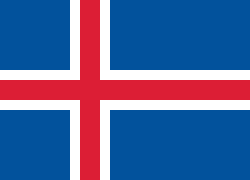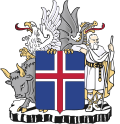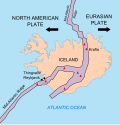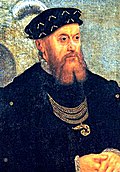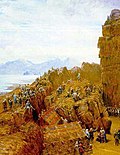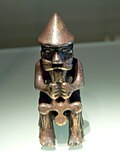Portal:Iceland
The Iceland Portal
Iceland is a Nordic island country between the North Atlantic and Arctic Oceans, on the Mid-Atlantic Ridge between North America and Europe. It is culturally and politically linked with Europe and is the region's westernmost and most sparsely populated country. Its capital and largest city is Reykjavík, which is home to about 36% of the country's roughly 380,000 residents (excluding nearby towns/suburbs, which are separate municipalities). The official language of the country is Icelandic. Iceland is on a rift between tectonic plates, and its geologic activity includes geysers and frequent volcanic eruptions. The interior consists of a volcanic plateau with sand and lava fields, mountains and glaciers, and many glacial rivers flow to the sea through the lowlands. Iceland is warmed by the Gulf Stream and has a temperate climate, despite being a latitude just south of the Arctic Circle. Its latitude and marine influence keep summers chilly, and most of its islands have a polar climate. According to the ancient manuscript Landnámabók, the settlement of Iceland began in 874 AD, when the Norwegian chieftain Ingólfr Arnarson became the island's first permanent settler. In the following centuries, Norwegians, and to a lesser extent other Scandinavians, immigrated to Iceland, bringing with them thralls (i.e., slaves or serfs) of Gaelic origin. The island was governed as an independent commonwealth under the native parliament, the Althing, one of the world's oldest functioning legislative assemblies. After a period of civil strife, Iceland acceded to Norwegian rule in the 13th century. In 1397, Iceland followed Norway's integration into the Kalmar Union along with the kingdoms of Denmark and Sweden, coming under de facto Danish rule upon its dissolution in 1523. The Danish kingdom introduced Lutheranism by force in 1550, and the Treaty of Kiel formally ceded Iceland to Denmark in 1814. Influenced by ideals of nationalism after the French Revolution, Iceland's struggle for independence took form and culminated in the Danish–Icelandic Act of Union in 1918, with the establishment of the Kingdom of Iceland, sharing through a personal union the incumbent monarch of Denmark. During the occupation of Denmark in World War II, Iceland voted overwhelmingly to become a republic in 1944, ending the remaining formal ties to Denmark. Although the Althing was suspended from 1799 to 1845, Iceland nevertheless has a claim to sustaining one of the world's longest-running parliaments. Until the 20th century, Iceland relied largely on subsistence fishing and agriculture. Industrialization of the fisheries and Marshall Plan aid after World War II brought prosperity, and Iceland became one of the world's wealthiest and most developed nations. In 1950, Iceland joined the Council of Europe. In 1994 it became a part of the European Economic Area, further diversifying its economy into sectors such as finance, biotechnology, and manufacturing. (Full article...) Selected article -The Icelandic Phallological Museum (Icelandic: Hið íslenzka reðasafn [ˈhɪːð ˈistlɛnska ˈrɛːðaˌsapn̥]), located in Reykjavík, Iceland, houses the world's largest display of penises and penile parts. As of early 2020 the museum moved to a new location in Hafnartorg, three times the size of the previous one, and the collection holds well over 300 penises from more than 100 species of mammal. The museum also holds 22 imagined penises from creatures and peoples of Icelandic folklore. In July 2011, the museum obtained its first human penis, one of many promised by would-be donors. Its detachment from the donor's body did not go according to plan and it was reduced to a greyish-brown shriveled mass that was pickled in a jar of formalin. The museum continues to search for "a younger and a bigger and better one." In the meantime, they have begun exhibiting a cast of Matt Barr of Great Britain who has "the longest urinary measurement ever recorded and...the longest and girthiest phallus, of any man alive today." (Full article...) Selected picture Öxarárfoss is a small waterfall in and one of the main attractions of Þingvellir National Park, Iceland. It flows from the river Öxará. The base of the waterfall is filled with rocks and is often very icy in winter. News
Main topicsSelected biography -Leif Erikson, also known as Leif the Lucky (c. 970s – c. 1018 to 1025), was a Norse explorer who is thought to have been the first European to set foot on continental America, approximately half a millennium before Christopher Columbus. According to the sagas of Icelanders, he established a Norse settlement at Vinland, which is usually interpreted as being coastal North America. There is ongoing speculation that the settlement made by Leif and his crew corresponds to the remains of a Norse settlement found in Newfoundland, Canada, called L'Anse aux Meadows, which was occupied approximately 1,000 years ago. Leif's place of birth is unknown, although it is assumed to have been in Iceland. His father, Erik the Red, founded the first Norse settlement in Greenland, where Leif was later raised. Following his voyage to Vinland and the subsequent death of his father, Leif became chief of the Greenland settlement. He had two known sons: Thorgils, born in the Hebrides; and Thorkell, who succeeded him as Greenland's chieftain. (Full article...) Did you know (auto-generated) -

Selected quoteGeneral imagesThe following are images from various Iceland-related articles on Wikipedia.
Selected panoramaCategoriesThings you can do
Wikipedia in Icelandic
Recognized content
New articlesThis list was generated from these rules. Questions and feedback are always welcome! The search is being run daily with the most recent ~14 days of results. Note: Some articles may not be relevant to this project.
Rules | Match log | Results page (for watching) | Last updated: 2025-04-16 20:57 (UTC) Note: The list display can now be customized by each user. See List display personalization for details.
Web resources
Associated WikimediaThe following Wikimedia Foundation sister projects provide more on this subject:
SourcesDiscover Wikipedia using portals | |||||||||||

